This week we continue to walk through a series of 40 images from my second Japan Winter Wildlife tour for 2016, when we visited the “Sound of Wings” bridge for a second time before moving on to perhaps the best two days with Whooper Swans that I’ve yet experienced.
On the sixth morning of the tour we had our second crack at Otowabashi, or “Sound of Wings” bridge, in the hope of beating the first day there, when there was actually a little bit too much mist to maximize our opportunities with the wonderful hoar frost covered trees.
As we left the hotel shortly after 4am, I was pleased to see that the outside temperature was about 3 degrees warmer than the previous day, giving us a temperature of probably around -18°C (0°F) which is perfect conditions for the hoar frost and not so cold that there is too much mist. We waited on the bridge, our places secured, for around an hour as the dawn light started to illuminate the scene.
I start shooting long exposures mostly to see what the scene looks like, but then as the light got better, we were treated with scenes like this one (below). We’d been at the bridge for about two hours by the time I shot this, so the sun was directly falling on the right side of the scene, but the white helps to reflect light around, so you don’t really get a harsh shadow from the trees along the left bank of the river.
Right now, I’d say this is one of my recent favorites from this location. My first nice photo from here was an image I called “Distant Dance” from way back in 2008. I still love that photo, although it was demoted out of my Nature of Japan portfolio a number of years ago now.
In some ways, I’d say that my old photo may have this beat, but here I do like the formation of the three cranes in the right foreground, looking as though they’ve been shunned by the forth, and the four pin-tail ducks along the bottom edge, anchoring the photograph. Then of course, the stars of the show, the pair of dancing cranes in the left background, that aren’t initially obvious. You have to work a little before you find them, and I like that in a photograph. It’s like an Easter egg, that a kid has to look around the house for in excitement, before finding their reward.
My settings for this photo were 1/500 of a second at f/11, ISO 640, at 420mm. I was using the 200-400mm lens with the 1.4X Extender engaged, but had pulled back a little to include more of the scene, and show the cranes in their roost environment. Again, this is not cropped, so I have the full 50 megapixels to work with. I am really enjoying getting high resolution shots like this, that I can add to my portfolios. My original Distant Dance was 21 megapixels, shot with the 5D Mark II, so it was fine for printing large, but having this new photograph at 2.5X the resolution really opens up options for really large prints.
Another favorite from this morning is this next image (below) of a pair of cranes dancing in the foreground this time. I like the poses on the dancing cranes here, and there is also a crane calling to the left, in the foreground, which adds an additional element of interest. The trees once again are quite pretty, and I just find this to be a generally pleasing scene to look at.
My settings were almost the same as the previous image, except that I have decreased the ISO from 640 to 500. I generally shoot in manual mode, and simply keep an eye on my histogram and the blinkies, and as the scene starts to get brighter, I bring down the ISO a further each time, to keep the whites white, but not overexposed.
This second morning at the bridge certainly beat the first for this trip, and I think that this is the first year where we’ve had the hoar frost and mist on both tours, as this doesn’t happen every day, so this was another added bonus, especially when you consider how the El Niño weather patterns had taken some opportunities away from us this year.
After breakfast, we took a steady drive over to Lake Kussharo, where we were to spend the next two days photographing the beautiful Whooper Swans. When we first arrived, we called in at a little corner of the lake called Kotan, where I made this photograph (below). Now, I know that some of you aren’t going to get this, especially if you have your display brightness turned up quite high, but if you look carefully, you’ll be able to make out the face of a swan through the mist.
There are hot springs that flow into the lake in a few locations, and on cold days, that causes mist to rise, and although it’s only in a small area of the lake, with a long lens, you can isolate your subjects enshrouded in the mist, just like this, and I love this kind of image. Again, there’s an Easter Egg element here; you have to work to see what the image is about. All of the image information in this photograph is in the top 15% of the histogram, so really, if your monitor is too bright, you just won’t see this. I am really looking forward to printing this as well though. These tones come out really well on a subtle matte fine art paper like Breathing Color’s Pura Bagasse Smooth.
My settings for this image were 1/800 of a second, f/5.6, ISO 400, at a focal length of 400mm, with my 100-400mm lens. Although I often photograph large birds at f/8 or f/10, here, I opened up the aperture as wide as it will go for this lens at 400mm, to get as shallow a depth-of-field as possible, to emphasize the dreamy feeling of the rest of the scene. I also dropped a small Radial Filter over the main swan’s face and neck in Lightroom, and set the Shadows slider to -15, the Clarity to 55 and the Sharpness to 38, just to give the main character a little more body.
Later in this first day with the swans, we tried to do some panning, but the swans weren’t being very cooperative. We had a few chances and I have some images, but I have a better one from the next day, which we’ll look at later, so for now, let’s move on to the dawn shoot on the following morning. As we approached the lake from the hotel, we were happy to see a beautiful band of mist across the surface of the lake, that we can see in the background of this photo (below).
I love it when there is something in the air to give the image atmosphere, and the distant mountains on the other side of the lake add a lovely bit of additional interest to these next few shots. Here I released the shutter as the swans were in front of the central band of mist, and I have added a Graduated Filter in Lightroom, just across the bottom white band, which is the frozen lake, and I reduced the Dehaze slider, just to take the edge off a little bit of contrasty snow that was visible down there. I thought this cleared up and simplified the image nicely. My settings were 1/1000 of a second at f/10, ISO 400 at 188mm.
We had been standing by the lake for almost an hour before the swans started to fly in, but once they started, we had a number of beautiful opportunities, with the mist, and also some hoar frost on the trees to our right, as you can see in this image (below). I have two frames of this pair that I like, one with them a little bit further to the left of the frame, clear of the trees. Depending on my mood when I look at them, I think I prefer that image, but I am happy with them both.
My settings were the same as the last image, and I have added another Gradient filter in Lightroom just to take the edge off the texture in the snowy surface of the frozen lake again. As we shot the swans, the sun was just coming over the trees to our backs as we faced the lake, so the light at this time of day is beautiful.
Just twenty minutes after the previous photo, I shot this one, and you can see how the mist has now receded down to a much thinner bank, enabling us to see the mountains behind the trees, which weren’t visible at this angle before. Here I have photographed the swans in the distance as they rounded the line of trees, flying in to this spot from their roost (below).
Luckily the hoar frost on the trees was still there, and again, this is one of those shots that you have to work for a little. This will also look great in a large print, where the viewer would more easily find the line of swans, but I hope you can appreciate it at the web size as well. My settings were the same as before, except just a touch of extra light allowed me to reduce my ISO from 400 to 320, again, just trying to maintain the optimal exposure without blowing out any of the whites.
Just 30 seconds later, I shot the same group as they approached, just before they flew almost overhead, in this photo (bel0w). I’ve included this, because I recall explaining to one of the participants, how important it is to develop the ability to zoom out as a group of birds approaches like this. I had gone wide for the last shot, but then zoomed in to get closer shots of the swans, and was by this point zooming back out again as they approached.
In many ways, this seems obvious, but the person I was talking to looked at me as though to say, “that’s way too much stuff to think about at one time!” And you know what, when you are just getting started, or trying to photograph birds in flight for the first time, it can seem quite daunting. As we hone our skills, and parts of our shooting become second nature, they become automatic, and we stop having to think about them. I don’t have to think about keeping my focus points over at least one of these birds, or refocusing if it runs off. I don’t have to think to press the back focus button, because my shutter button doesn’t activate the focus mechanism.
I do still think actively about how I am composing an image, although I’m drawing from experience and it’s an easy set of decisions, including trying new things from time to time. And, I don’t have to think about exposure, because I’ve done all that before the action starts, and it won’t change because I’m in Manual mode. Finally, as this group of birds approaches, I don’t have to think about zooming out, at least not any more than sending a few signals to my hand to make it twist the zoom ring while composing and doing all of that other stuff.
When you list it all out like this, we are actually doing quite a lot of complicated stuff all at once, and if any of these things require more than a little bit of thinking, it can stop the others from happening altogether, and that’s what happens when people are just getting started. So, how do you get good at doing this stuff? You keep doing it, again and again, consciously thinking of what you need to do, until it becomes second nature, and automatic. Repetition and practice is the only way to get used to doing this stuff, and the more you do it, the better you get.
I feel very comfortable with the technique of shooting these days, and really now am in a mode where I’m trying to tweak my composition and timing to make better and better photographs as the opportunities provided by each subject and location allow.
Of course, I also find myself in situations occasionally when I’m still challenged, and that’s great. It would get boring otherwise, but I wanted to talk about this really to impress on you the importance of practicing your craft. And, perhaps even more importantly, that it’s OK to be overwhelmed at first, because we do a lot of things in parallel, but with practice, it does get easier. So, if that’s where you are in your photography, don’t worry too much about it. Stick with it, and it will come.
After breakfast back at the hotel, we went back out, back to Kotan, and were happy to find that the mist was still there. I love to capture the moments when the swans stretch up and flap there wings a few times, like we can see in this photograph (right).
As I’ve mentioned, I set my exposure in Manual mode when I first arrive at a scene, so I don’t have to think about that when these birds rear up. There is literally just a split second to grab focus, and recompose, but it works sometimes, and the results can be nice.
The mist adds so much to this scene of course, and the dark trees across the top of the frame really add to the dreamy feel, as do the rushes along the bank of the lake, gradually fading into the distance. Again, I feel that mist in a scene like this really does literally add atmosphere.
After spending the rest of the morning photographing the swans at Kotan, we went back to the hotel for lunch, and had a couple of hours in a workshop session, before going back out again at 3:15pm, to try out hands at the panning again. We had a few more chances this time, and most of the group seemed to get something that they were happy with, like this shot (below).
This is a fun technique that I like doing with the group. We set our cameras to a shutter speed of 1/50 of a second, and as it was getting dark, this still required an ISO of 400 at f/11 to get a nice exposure. A 50th of a second is a good speed for this technique. If you go much slower the success rate drops dramatically, and if you select a much faster shutter speed, the background becomes sharper, and the wing movement is not as pleasing. Of course, it depends what you are panning with, and your focal length, but for large birds I find this to be the sweet spot.
The following morning, it was forecast to be snowing, so we rose to a changed plan of going back to lake for another fly-in shoot, rather than our optional shoot at Bihoro Pass which we do sometimes, when weather permits. There’s no point in being on a mountain in cloud and snow though, as we wouldn’t be able to see the scene, so I’d changed our plan.
I’m really pleased I did too. The swans flew in again a number of times, and were in a beautiful mist again, but this time, with snow in the air. We’ll look at a few more images next week, but for now, let’s close with this shot of two Whooper Swans that are just landing, with mist and snow in the air (below).
I know this might sound a little bit conceited, but I absolutely love this shot. I enjoy close up images where the subject fills the frame, but sometimes, I also really enjoy having them occupy a much smaller area of the frame, with lots of negative space, as I’ve done here. I shot this at 300mm, so I could have zoomed in further, but I decided to go with this composition instead.
I just love the softness of this image, with the birds in two different poses, with one walking on the snow by now, and the other still floating six inches above it. I’ve done nothing to this is post, not even a spot of Clarity as I often do. I wanted to leave the softness there, and the feeling of the mist and snow in the air. It feels like these two birds are just sitting in a huge soft box. It was a beautiful quality of light. My settings were 1/400 of a second at f/10, ISO 1000, at 300mm.
OK, so we’ll wrap it up there for this episode. I’ll be back next week where we’ll take a look at a few more images of these Whooper Swans in the soft box, before going on to Sulphur Mountain and the Sea Eagles, in part three.
2018 Winter Wonderland Tours
Before we finish, I’d like to remind you that we are now taking bookings for the 2018 Snow Monkeys & Hokkaido Tours. For details and to book your place, visit the tour page at https://mbp.ac/ww2018. Our 2017 tours are already sold out, but if you’d like to be put on the wait list, please contact us.
Show Notes
Details of the 2018 Tours: https://mbp.ac/ww2018
Subscribe in iTunes for Enhanced Podcasts delivered automatically to your computer.
Download this Podcast in MP3 format (Audio Only).
Download this Podcast in Enhanced Podcast M4A format. This requires Apple iTunes or Quicktime to view/listen.


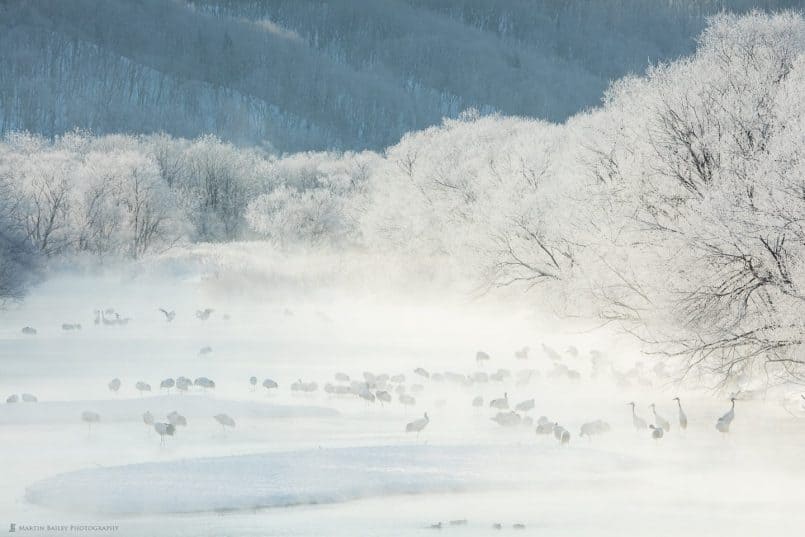
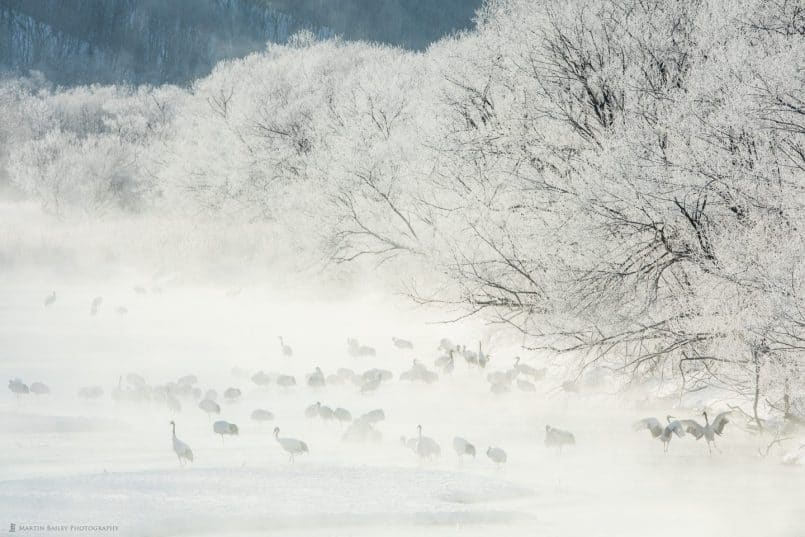
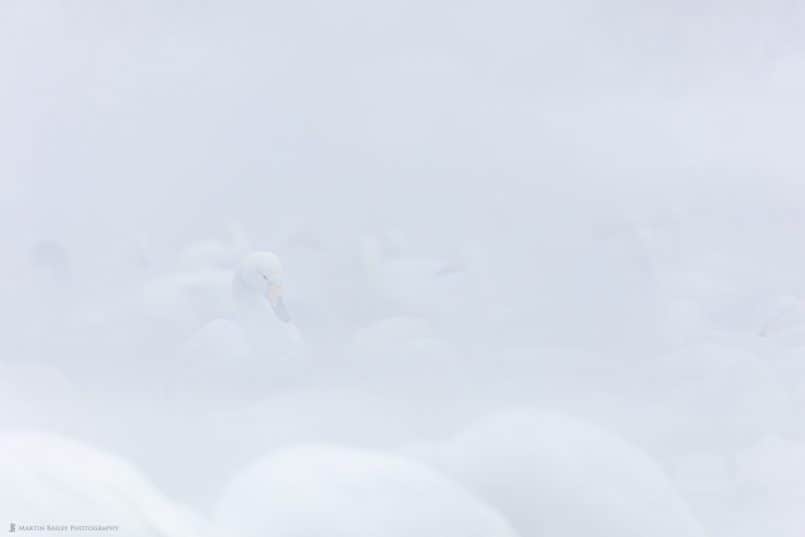
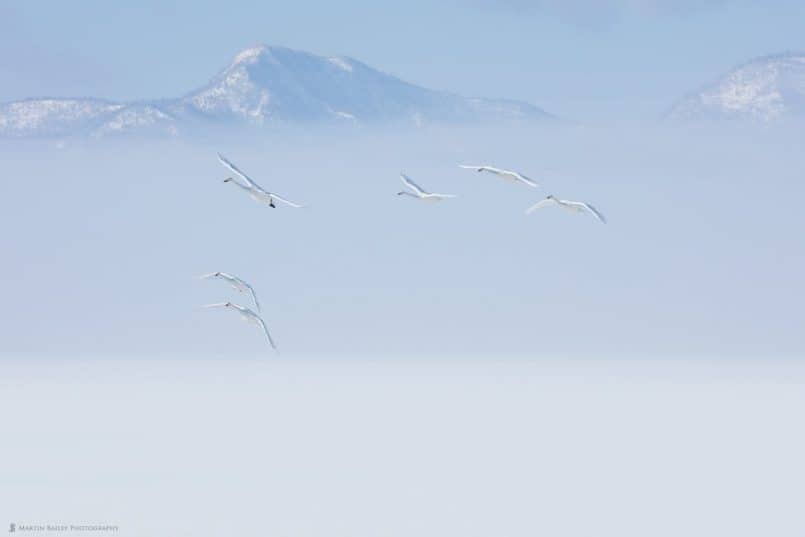
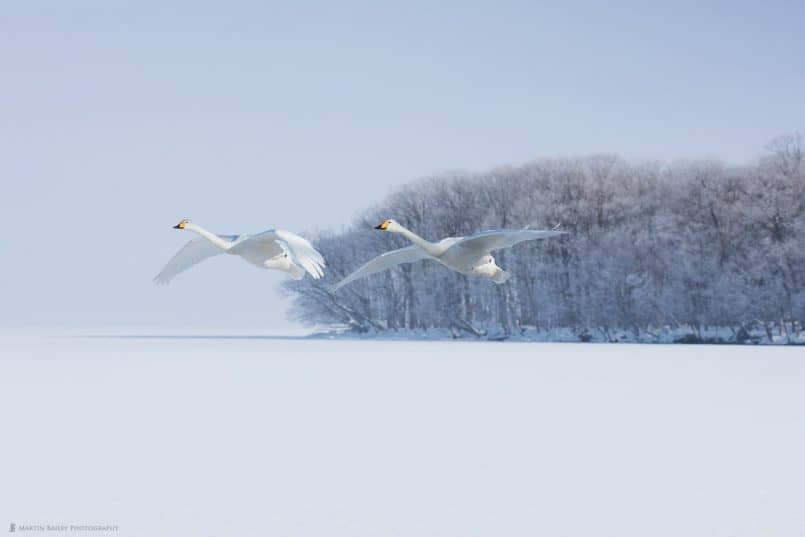
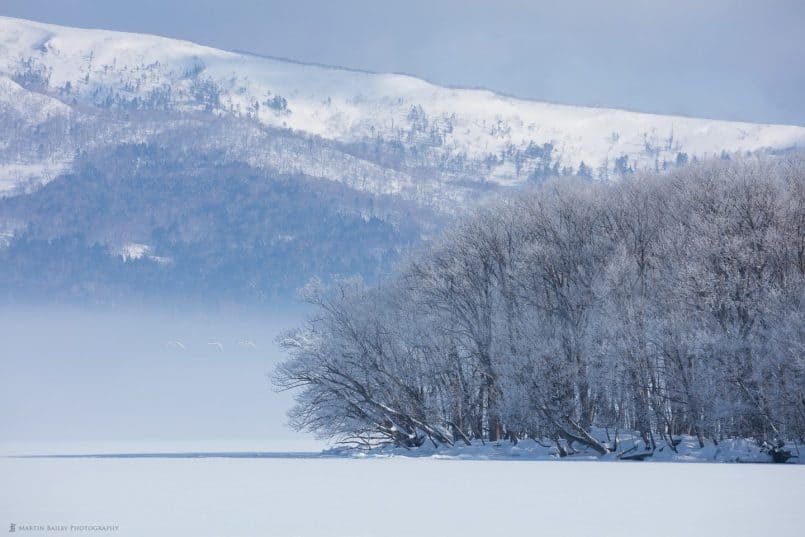

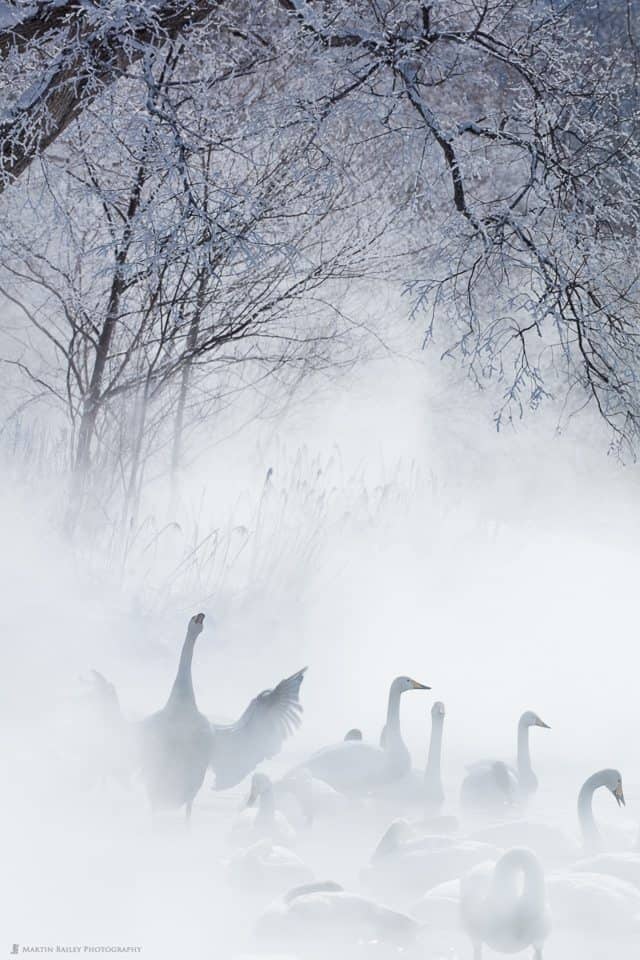
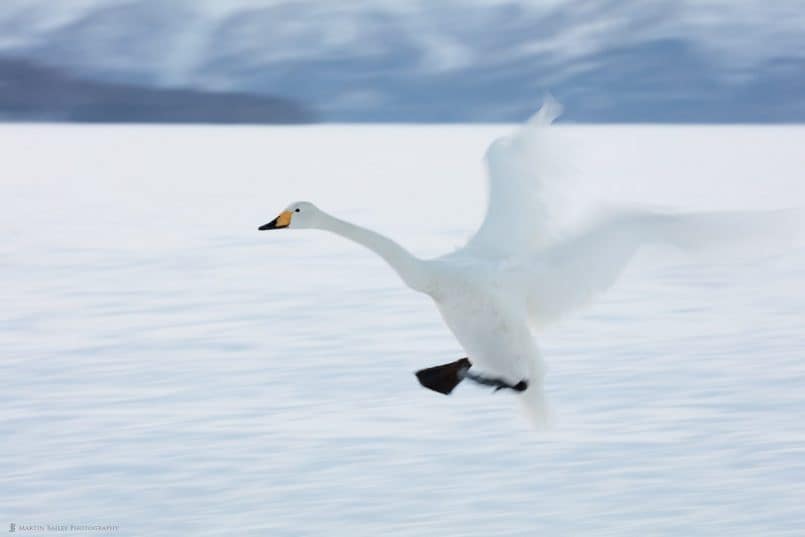
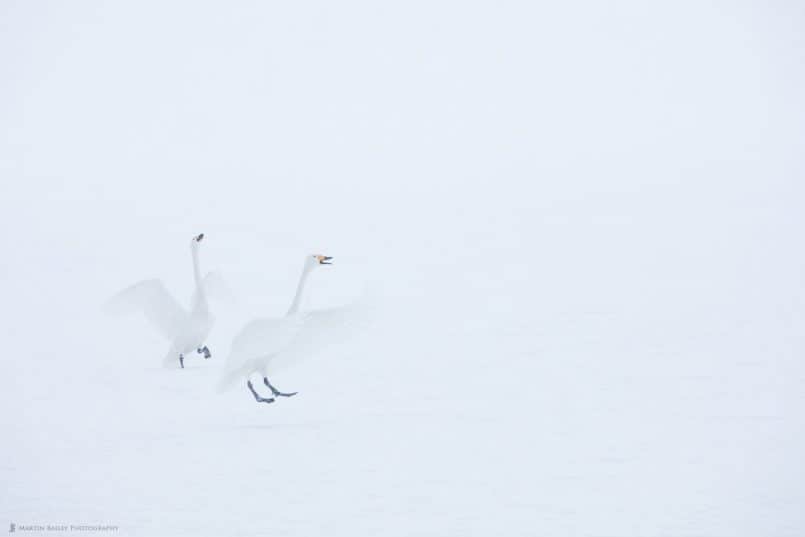
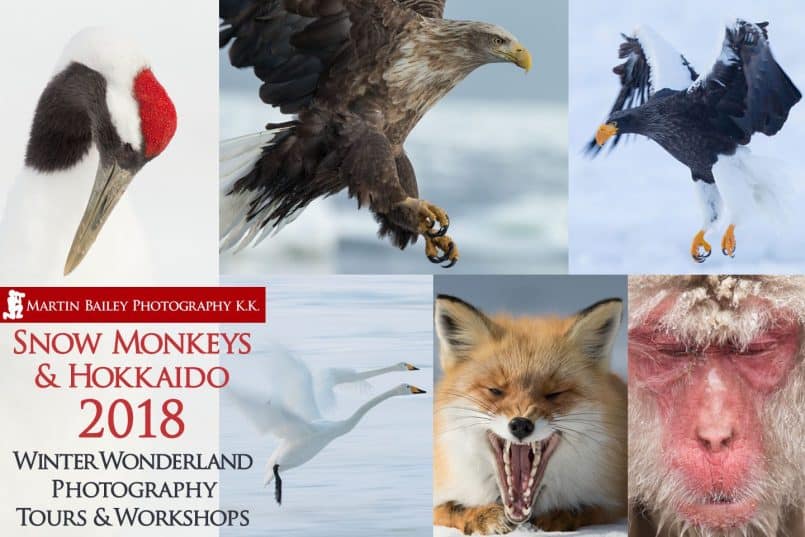

The bridge pictures are lovely. What beautiful compositions.
Thanks Lynne! I’m pleased you like them.